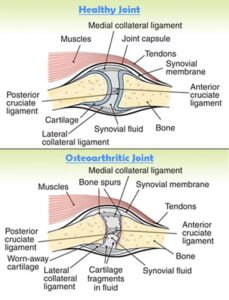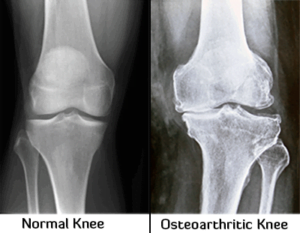A Normal Joint
A joint is where two or more bones meet. A joint allows your bones to move freely but within controlled limits.
To prevent friction and erosion of bone the ends of your bones are coated with a layer of tough, slippery tissue called cartilage. Cartilage acts a bit like a shock absorber to spread the load more evenly across your joint. Also most joints have a small amount of synovial fluid in them which acts like a lubricant. Your knees have extra rings of cartilage between the bones. These are called menisci.
Although fractures might not be entirely preventable there are ways to minimize your fracture risk. One way is by building stronger bones and keeping them healthy.
What is Osteoarthritis?

It is a medical condition that affects your joints. In osteoarthritis (Sometimes called OA), there is gradual degradation of the joint cartilage due to wear and tear. A variety of causes like hereditary, developmental, mechanical and metabolic – initiate a process of cartilage degradation. As this process continues, the cartilage loses its ability to act as shock absorber. At some places there may be so much wear that the underlying bone becomes exposed and starts rubbing against each other. This causes pain and stiffness and its difficult to use the joint. There is also loss of structure and function of the supporting ligaments and muscles , causing instability.
It’s the most common type of arthritis commonly affecting the hip, knee and spine. However any joint can be affected. The chance of osteoarthritis in a joint increases with age. Most people above the age of 60 get osteoarthritis to some degree.

What are the signs and symptoms ?
Pain in the affected joint is the commonest symptom. Joint pain of osteoarthritis is usually worse later in the day. There can be swelling, warmth, and creaking noise in the affected joints. Pain and stiffness of the joints can also occur after long periods of inactivity (for example, sitting in a theater, getting up from bed in the morning etc.). In severe osteoarthritis, there can be pain even at rest or pain with limited motion and walking can become extremely difficult.
OA in the fingers and hands can limit fine movements. In the spine it can cause persistent neck or back pain.

Diagnosis of osteoarthritis
Diagnosis is straightforward based on :
- Your description of symptoms
- Physical examination by your physician
- X-Rays
- MRI
Sometimes your doctor may prescribe blood tests to make sure you don’t have other type of arthritis.
Types of Osteoarthritis
1. Primary : Occurring due to normal wear and tear of a joint.
2. Secondary : Due to an underlying cause like —
- Inflammatory diseases / arthritis, such as rheumatoid arthritis
- Previous Injury
- Obesity
- Inactivity or sedentary lifestyle
- Genetic
Treatment of osteoarthritis
Early Stages – (Grade 1)
Osteoarthritis treatment depends on the grade of disease progression. In early stages the treatment comprises of a combination of-
- Exercises
- Physical therapy
- Nutritional supplements
- Weight loss
- Medicines
- Hot and cold compress
- Application of pain reliving ointments / gels / oils
Intermediate Stages – (Grade 2, Grade 3)
With the progress of the disease your doctor may prescribe injection of medications into the joint. These can be either steroid injections or specialized gel formulations.
Late Stages – (Grade 4)
Surgery may be helpful to relieve pain when other treatment options have not been effective.
Both Hip replacement surgery and Knee replacement surgery have shown excellent long term results in treatment of severe arthritis.
The type of treatment will depend on several factors, including your age, occupation, activities , overall health, medical history, location of your osteoarthritis, and severity of the condition.
